
In China’s far north,
a once-proud tradition of reindeer herding
breathes its last.
INNER MONGOLIA, North China — By any measure, He Xie is drunk. But as he strides up the rutted track to the bluff where a herd of reindeer has gathered, he appears to shake off the effects of the beer he downed on his way into the mountains. Tinkling a little bell, he methodically lures a doe away from the group, coaxing her into a corner of the enclosure.
He Xie is one of the Evenki community’s most esteemed reindeer herders, and he’s about to cut off a reindeer’s antlers. Velvet antler — the stage before the protrusions calcify into bone — fetches high prices in the field of Chinese medicine, as it is thought to enhance male virility.
Reindeer, normally such docile animals, get nervous when they see He Xie. They eye him warily across the bluff and bolt when he draws near. He Xie fashions a snare from a length of rope and draws it tight around the doe’s leg, immobilizing her. He marshals her into a narrow gap between two felled pines, deftly pinning the deer’s head against a tree with his sinewy arms.
When the first cut comes, the doe panics. She snorts violently and stamps at the ground; her bulging eyes stare upward at her assailant. He Xie shoves her head back against the tree. Three sharp yanks later, he jerks the antler from the doe’s head and places his hacksaw off to one side.
Blood spurts from the stump left behind, gushing onto He Xie’s face, his shirt, his shoes. He leans forward to catch some in his mouth, holding a bowl beneath the flowing crimson liquid and mixing it with , a potent liquor, before lifting the concoction to his lips.
A Culture for Sale
We’d met He Xie a day earlier, when he sidled over and started chatting with us on a warm evening in New Aoluguya, a purpose-built settlement where, 15 years ago, the Chinese government relocated 62 households from the Evenki ethnic group.
Evenki reindeer herders have dwelled in China’s frigid far north for nearly two centuries. The Evenki are one of the country’s 55 officially recognized ethnic minorities and have a population of a little over 30,000, but only around 160 still tend reindeer in the quiet, beautiful forests of larch, pine, and birch in the Inner Mongolia Autonomous Region.
Fewer still live in ways that resemble traditional Evenki culture. New Aoluguya is a sleek, modern settlement: Families reside in warm, timber-clad houses designed in the late 2000s by the Finnish firm Pöyry, evenly spaced along well-kept streets with gardens out front. Most say life here is better than that of their ancestors, who drove their reindeer through the forests and hunted wild game for survival.
He Xie cuts reindeer antlers at a camp near Genhe, Inner Mongolia. Note: This video contains scenes that some viewers may find upsetting.
But some worry that leaving the forest has eroded — if not destroyed — what it means to be Evenki. Elderly herders speak nostalgically of childhoods spent huddled in birch-bark tents, watching now long-dead shamans caper around crackling campfires. A few Evenki eke out isolated existences deep in the forest, fearing that departure from the mountains will irrevocably sever their ties with their beloved reindeer. And in New Aoluguya’s tourism zone, as dark winter days spent indoors break into long summer days with few visitors, some herders pass the time smoking, eating, and drinking copious amounts of alcohol.
Where the last vestiges of Evenki culture cling on, they usually exist in neatly packaged, consumer-friendly forms for the small number of tourists who venture this far north. Throughout New Aoluguya, red plastic signs advertise Evenki homestays, deer antler sells for more than 5,000 yuan ($700) per kilo, and deer-bone necklaces retail at 700 yuan apiece.
Our encounter with He Xie showed us that there’s a fine line between authentic Evenki culture and tourism-inspired performance.
When we meet him, the slightly stooped 56-year-old is in effervescent form, reminiscing about his past life as a hunter and wheezing out a few songs on his harmonica. We’ve heard that He Xie plans to saw off some antlers this year — reindeer antlers grow back annually — and ask if he’s heading into the mountains soon so we can film him. “I can take you tomorrow,” he replies.
Early the following morning, while waiting for his friend — another herder — to arrive, He Xie downs a couple cans of beer. On the drive out of town, he stops to buy more, swigging drowsily from the passenger seat while the other man takes the wheel.
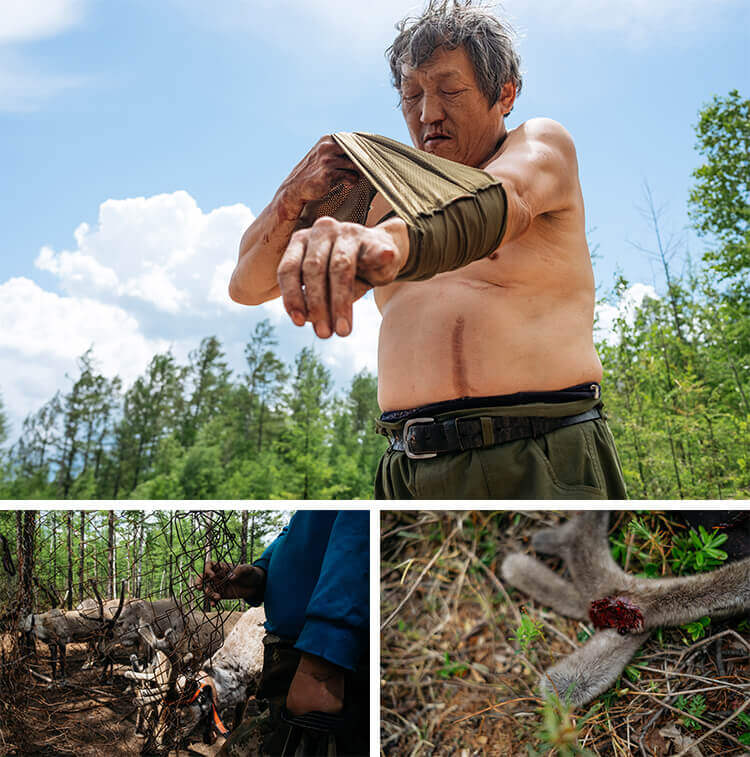
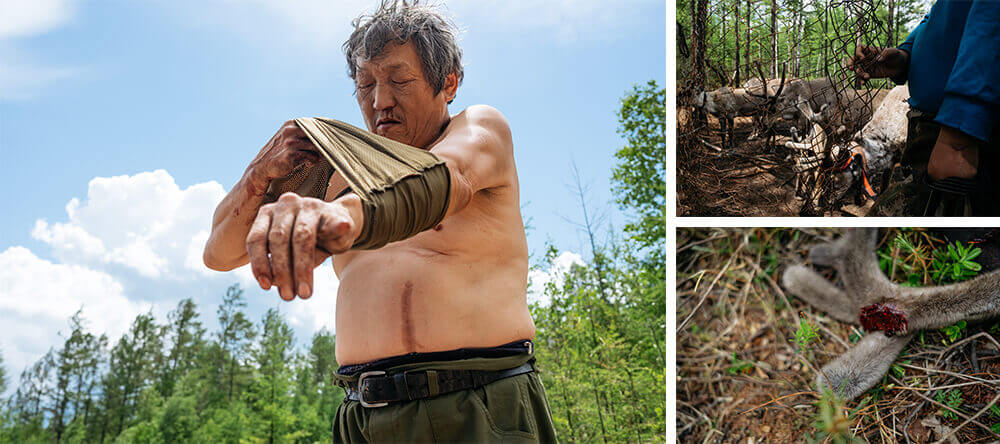
After cutting antlers, He Xie wipes blood from his face with a T-shirt (above) while a number of other reindeer wait in a pen (bottom left). A freshly cut antler lies on the ground nearby (bottom right).
After cutting antlers, He Xie wipes blood from his face with a T-shirt (left) while a number of other reindeer wait in a pen (top right). A freshly cut antler lies on the ground nearby (bottom right).
Then follows the bloody episode in the forest — a rare and visceral sight, one that, as journalists, we feel privileged to witness. But on the way back to the truck, He Xie’s friend takes one of us aside. “That’ll cost you 1,000 yuan,” he says, going on to imply that without the payment (equivalent to about $150), He Xie will become angry and unstable.
Naturally, we protest. We tell him that He Xie understood we were journalists before we left, and that it is unethical for us to pay for interviews. But the man is unmoved. “That’s the price. You’ve brought him all the way out here; you’ve taken up his time and expertise,” he says, naming other, more prominent media outlets who he alleges paid more for a formal interview. “He wouldn’t have done it otherwise.” Feeling like we have no other option, we pay up.
On the way home, He Xie slumps in the sunlit passenger seat of the truck that brought us into the forest. He slurps a can of warm beer — his sixth or seventh of the day — as he turns his lined face in our direction, dozily telling us stories of his upbringing spent tending reindeer in the wilderness, decades before he got rich selling his culture to tourists, journalists, and filmmakers. It feels a little like he’s throwing in an extra service.
The Forests and the Animals
Even Evenki who try their best to carry on their herding culture struggle to do so.
He Lei — likely a distant relative of He Xie, as many are in this tight-knit community — has not seen his reindeer in nearly two weeks and is starting to worry. He swats irritably at the clouds of mosquitoes humming in the forest air and waves a satellite tracking device toward the summer skies, more in hope than expectation.
“Where have they gone?” he murmurs to himself.
He Lei fiddles with the tracker some more, but to no avail. We clamber back into his pickup truck and barrel down another rutted track toward a different part of the forest.
At first, it looks like another false alarm. But then, the faint tinkle of a bell emerges from the trees, followed by a snort, and all at once around 20 reindeer come trotting toward us, tossing their magnificent heads in an attempt to ward off flying insects. He Lei is visibly relieved; he empties a bag of feed onto the ground and leaves the reindeer to their lunch.
Such is the modern herder’s life, one of GPS trackers, long truck rides, store-bought feed — and bureaucracy. These days, He Lei must submit paperwork and pass through checkpoints just to see his animals. “We’re restricted,” he grumbles. “We can’t go here, we can’t go there.”
He Lei is a giant of a man. Broad-shouldered and barrel-chested, he wears his hair in an unkempt tumble and stretches jazzy-colored T-shirts over his formidable belly. His lifestyle is fairly typical of today’s reindeer herders: He spends most of his time at home in New Aoluguya with his wife, 2-year-old daughter, and grandmother. His animals remain in the surrounding forest, where they forage for meager amounts of the lichen that’s supposed to form the mainstay of their diet. He Lei keeps a cabin in the woods.
He Lei says that reindeer herding — and Evenki culture itself — is dying out.
Winters are long and bitter. Genhe, the city that governs New Aoluguya, holds the record for China’s coldest recorded temperature, a soul-numbing minus 58 degrees Celsius. When the snows come, He Lei often spends several days in his cabin, rearing his reindeer on city-bought feed. Things get busier in the spring, when the doe give birth to lanky fawns. Some summers, He Lei saws off a few antlers and sells them for profit.
Life for today’s herders is a far cry from that of their ancestors. Historically, the Evenki lived in , close-knit communities of families linked through the male bloodline. The spent life permanently on the move, setting up camp every few days before heading on to new pastures when they or their reindeer had exhausted local food sources.
Evenki reindeer herders have little in common with their ethnic peers, most of whom work in farming and industry on the wide, open grasslands south of reindeer country. Traditionally, southern Evenki groups had relatively sedentary lives, raising conventional livestock on the region’s vast steppes. Meanwhile, reindeer herders lived as seminomadic hunter-gatherers, driving their animals through the remote boreal forests that adorn the slopes of the Greater Hinggan Mountains.
Herders did not kill their reindeer for meat. Instead, they viewed them as pack animals that provided humans with milk and transport in return for food and protection. Reindeer also played important religious roles. When a herder died, for example, the sometimes buried them alongside one of their animals to help them ride up to heaven.

A reindeer nibbles at a tree at a forest camp in Inner Mongolia.
The arrangement gave rise to an intimacy between herders and reindeer that runs far deeper than the bond between farmers and livestock. “I would call them friends,” says Lin Hang, an associate professor specializing in northeastern China’s ethnic minorities at Hangzhou Normal University. “Normally, the herders would know each reindeer and even have names for them. They would call them every morning, walk with them, and watch them eat. It was a very close relationship between animals and human beings that were sharing the same environment and resources.”
Evenki reindeer herders also felt a strong spiritual resonance with the forests they called home. Their religious beliefs held that spirits inhabited everything in nature, and the relied on shamans to commune with them in order to ward off misfortune.
But He Lei has never known that way of life. Since the 1950s, three government-sponsored resettlement campaigns — most recently in 2003 — have put Evenki reindeer herders into permanent accommodation in increasingly urban areas, cutting them off from their former herding grounds and straining their strong spiritual ties to both their reindeer and the forest. The social systems that underpinned their former lives have been superseded by modern housing, modern economies (first planned, then market-driven), modern education, and modern health care.
He Lei grew up in the original Aoluguya — the second government-built Evenki settlement around 250 kilometers from Genhe — and moved to New Aoluguya as a teenager. The government termed this 2003 resettlement “ecological migration,” claiming that the policy was essential to protect both the Greater Hinggan Mountains and Evenki cultural heritage.
The state argued that the move would allow a remote, impoverished group of herders to easily access the market economy, earn higher incomes through tourism, and preserve the unique traits of their ethnic minority. But to some Evenki people, it pushed an already-ailing culture into terminal decline.
“What ethnic minority?” asks He Lei. “There’s nothing left. People still talk about protecting our ethnic stuff, our ethnic distinctions. Protection my ass. There’s nothing left. We don’t raise deer; we don’t use them for anything. It’s gone.”

Today, herders are dislocated from their erstwhile pasturing lands, shamanism in the region is virtually extinct, and the local language — a variant of the Tungusic tongues spoken among the indigenous peoples of Siberia and northern Asia that is largely unintelligible to Mandarin speakers — is severely endangered. Reindeer numbers are dwindling, and few young people see a future in herding.
At Genhe’s barbecue joints and hot pot restaurants, local Han people frequently invoke the same metaphor to refer to their neighbors down the road. “The Evenki are like giant pandas,” one taxi driver says; they are lovable, flawed, and would be extinct save for careful isolation and the painstaking conservation efforts of people around them.
But there is more to this image than meets the eye. “It’s an animal in a cage as well,” says Åshild Kolås, a research professor at the Peace Research Institute Oslo who has studied China’s reindeer herders. “The giant panda has been commercialized, made into a mascot, put into products.”
Lin, the Hangzhou-based scholar, describes the results of ecological migration as “mixed.” “Although some people would’ve liked to live with their reindeer for most of their lives, that’s not everybody,” he says. “In the New Aoluguya settlement, more people have more opportunities for other types of jobs. But the other side is that it cuts off, to some extent, the very close link among human beings, animals, and the environment.”
The policy is at odds with the animals’ needs, too. Reindeer feed predominantly on lichen, a hardy, slow-growing plant-like organism that thrives in much of the Siberian taiga. But New Aoluguya lies in the southernmost reaches of this ecosystem, where lichen doesn’t grow in the abundance that reindeer need. Kolås says that, historically, Evenki herders would never have brought their animals into the region around the settlement. “There’s nothing to eat,” she says. “They can nibble on things, but they won’t survive there in the wild without food being brought to them.”
Policymakers initially intended to build enclosures in New Aoluguya where reindeer would be hand-fed, but that didn’t work, either. “Reindeer can’t be kept in pens; you have to let them roam free,” says He Lei, recalling that some animals perished in the immediate aftermath of the move due to a lack of lichen and outbreaks of disease. As the health of the animals deteriorated, officials and herders came to a compromise: The reindeer were released into the surrounding mountains, but their handlers continued to live in New Aoluguya.
As a result, some of today’s Evenki herders find themselves in a bizarre situation, periodically ferrying city-bought feed into the forest to sustain animals that would not survive there otherwise.
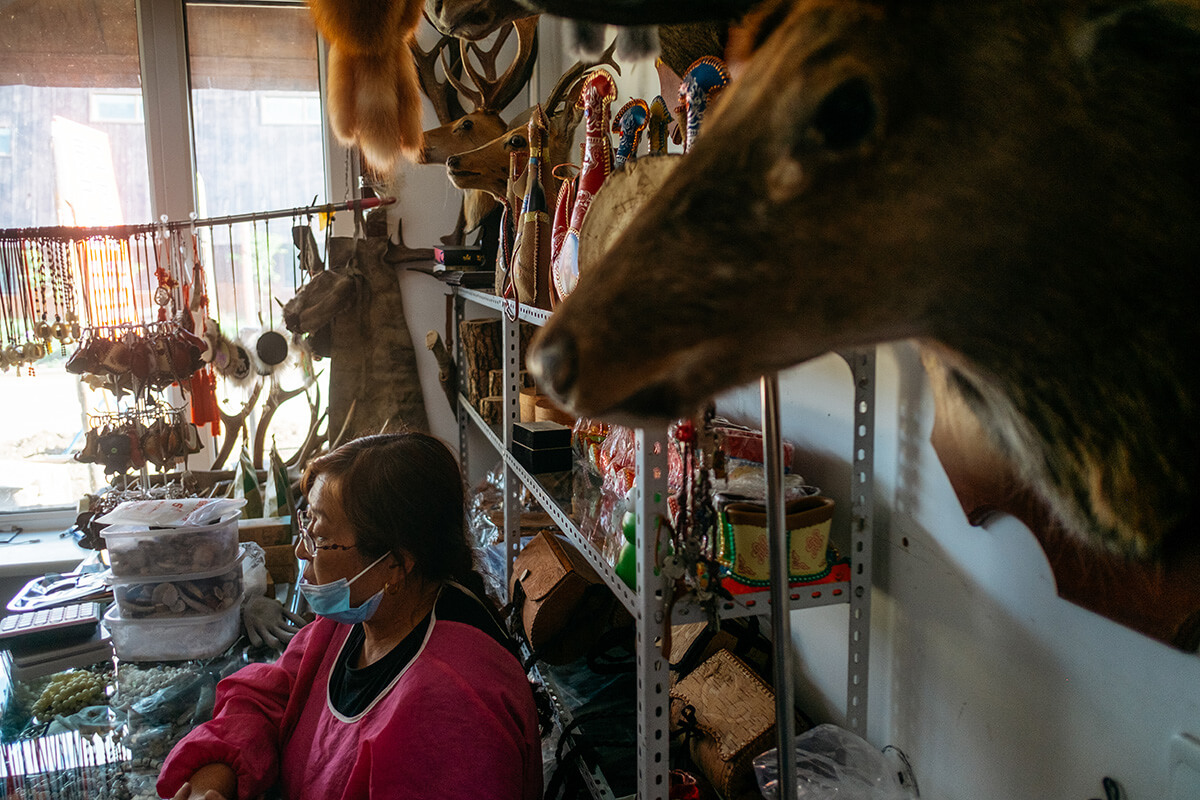
A number of shops in New Aoluguya sell deer products as souvenirs.
Since 2003, the state has rolled out additional policies in the name of environmental protection. But herders say the new rules are making it more and more difficult to access their reindeer. Their complaints are loudest in the summer, when the local forestry bureau closes off mountain tracks and strictly controls entry into the area to prevent fires. Although herders are allowed in, He Lei must spend several minutes informing checkpoint staff of his intended activities before the barrier is raised. Plans also exist to regulate access by granting licenses to individual herders, he says.
He Lei says many herders are frustrated with what they perceive as excessive meddling by the authorities: “How many years have we lived in the mountains? Hundreds of years — and did anybody set the place on fire?”
The summer calving season is a time when the herd is at its most vulnerable, he explains. “Before, during the calving season, people kept an eye on the reindeer when they gave birth, fearing that they’d be eaten by wild animals,” He Lei says, adding that wolves and bears are the main culprits. “But these days, the fire prevention work is tightly managed. You can’t go into the mountains, and you can’t light fires. The deer can’t reproduce properly, because the calves get eaten as soon as they are born. People can’t look after them.”
Consequently, according to He Lei, reindeer numbers are falling. “If you control everything this strictly, I think all the reindeer will die out,” he says. “They’ll last another eight to 10 years.”
Previously, the Evenki would introduce new bucks into the herd every year or two in order to maintain the quality of the gene pool, he continues. But with so few deer left, individual herds are inbreeding, which can result in decreased fertility, birth defects, and a higher risk of genetic disorders. In addition, the cost of introducing a buck can be prohibitive: He Lei estimates that buying a male outright would cost him 30,000 yuan, but leasing one commands an exorbitant fee, too. “I only make so much money a year,” he says, refusing to be specific.
Despite his gripes about bureaucracy, He Lei initially says that life in New Aoluguya is far more convenient than at the remote settlement in which he grew up. “Back then, a car came twice a month. You’d go [into town] twice a month and bring back enough food for two weeks,” he says. “Now, you can eat whatever you want.”
Moments later, however, He Lei contradicts himself. “Things aren’t as good as they used to be,” he muses. “It was more convenient before. You had less to worry about. If you wanted to go into the mountains, you just went — you didn’t have someone telling you to sign this and sign that.”
Before the Relocations
He Lei’s cabin — a basic sheet-metal hut propped on top of a few sawed-off logs — lies a 90-minute drive out of Genhe, a city-sized slab of rusted steel and concrete anchored in a sea of pine. Icicles still hang from the eaves of the cabin when we visit in March; He Lei’s reindeer lie contentedly in the snow out back.
Since China was reunited under Communist rule in 1949, the government has resettled the Evenki reindeer herders three times. In 1957, the state constructed a so-called ethnic township in Qiqian, a fur trading post on the Russian border. In 1965, amid China’s troubled relations with the USSR, the Evenki moved farther from the border to the original Aoluguya settlement near the town of Mangui. There they stayed until the most recent relocation in 2003.
Reindeer herders have more experience of resettlement than most people in China, but they are by no means an isolated example. The Chinese government regularly rehouses large groups of people in the name of modernizing pastoral communities, protecting the environment, improving access to amenities, or eliminating poverty. According to state news agency Xinhua, an estimated 3.4 million people were relocated last year, most of whom resided in impoverished areas that the government hopes to revitalize by 2020. As with the Evenki, relocated families often find it difficult to adapt to their new environs.
Lounging on one of the bunks in the cabin, her face wreathed in cigarette smoke, is Zhong Nihao, He Lei’s grandmother. At 77 years old, she is one of the few remaining Evenki to have grown up in the mountains prior to the resettlement campaigns. Until her mid-teens, Zhong lived an itinerant life in — teepee-like wood-and-bark tents known as in the Evenki language. “Three or four” other families and a couple dozen reindeer accounted for the rest of her , she says.
Zhong is still mobile and keen-witted, but old age is taking its toll: Her movements are slow, her legs ache, and her memory is fading. Nonetheless, she recalls snatches of a childhood lived the old way.
“Life in the was extremely hard,” she begins. “We slept on the ground. Grownups and children alike wore clothes made from skins and furs — we didn’t have [Han-style] cotton-padded jackets.”
Back then, the Greater Hinggan Mountains teemed with wild deer, squirrels, fish, and bears. Periodically, groups of hunters would leave the — the Evenki’s basic social unit — to shoot or trap game. Meat (though not from reindeer) formed the basis of the ’s diet, and food that wasn’t eaten right away was often smoked or dried. “We didn’t pick wild plants or mushrooms — we only started eating mushrooms after 1949,” Zhong says, referring to the Communist civil war victory known as “liberation” in Chinese.
The herding economy didn’t exist in isolation. Beginning in the 17th century, when Russia started expanding its influence into northeastern Asia, the Evenki were occasionally visited by itinerant merchants. Zhong’s was especially adept at hunting squirrels, which they sold to three regular traders from the Soviet Union. Historically, the border between Russia and China was much more porous than it is today. Evenki herders came and went largely as they pleased, and they sometimes intermarried with their non-Evenki neighbors. A few elderly Evenki have Russian names.
“[Squirrel] meat is delicious, and you could sell the pelts for money,” Zhong explains. “But at first, we didn’t want money. We exchanged the pelts for food: sugar, flour, oil, things like that.” In the summer, when food was plentiful and cold-weather furs were cumbersome and unnecessary, some herding groups left provisions in storehouses called , built in the trees to prevent marauding animals from getting in.
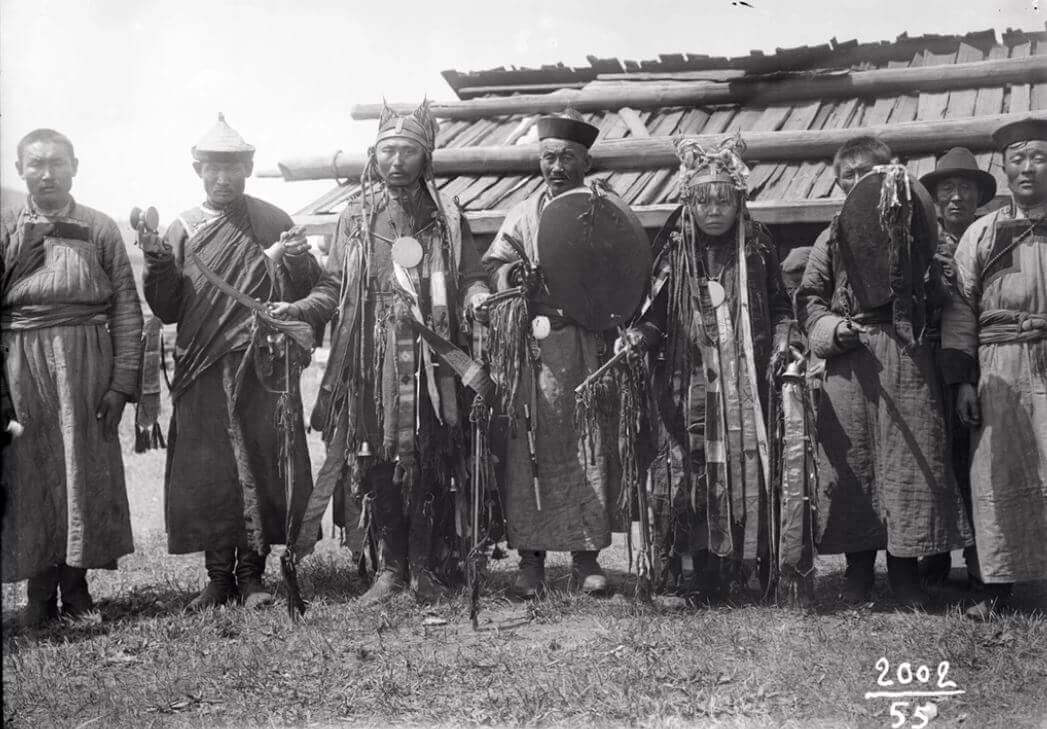
Religious beliefs, too, were part of everyday life in the . The Evenki were traditionally animists, believing that everything in nature possessed a distinct spiritual essence. These spirits could be benign or malevolent and influenced all naturally occurring events, including human endeavors. Because failure to respect the spirits’ wishes could lead to calamity in the human realm, the Evenki appointed religious adepts to commune with them in exceptional situations — if a herder went missing, if a child fell ill, or if a reindeer wandered off, for instance. In the Evenki language, these adepts were known as , meaning “seers” or “those who know.” This is the source of the English word “shaman.”
Animism and shamanism predate the world’s organized religions and emerged in cultures on every inhabited continent. Similar practices persist in China today, where ethnic minorities like the Yi, Tujia, Naxi, and Bai appoint people to mediate between the human realm and the otherworld.
According to research by Russian ethnologists who studied Evenki life in the early 20th century, after a shaman died, younger members of the would start behaving in strange ways. Many became work-averse and depressed; some even suffered from hysteria or convulsions. Seeking solitude, they would run off into the forest for extended periods of time, where it was believed that a spirit would settle in a chosen candidate, who would then go into a state of ecstasy. After recovering and returning to the camp, the new shaman-to-be might suddenly “go crazy,” as today’s Evenki describe it, leaping about in great agitation. This apparently signified that the spirit had possessed the youngster, who could then begin communing with the spirit.
One of the last Evenki shamans in China was a woman named Olga Dmitrievna Kudrina. According to Zhong, Kudrina was her great-aunt, and the shaman spent long periods in Zhong’s during her infant years.
Zhong grew up in the shadow of the Second Sino-Japanese War. During her childhood, Japanese soldiers occupied most of the region where her roamed, periodically forcing Evenki men to work for them as scouts or take part in military exercises. Once, Zhong recalls, the Japanese abducted a 13-year-old boy from her group:
“He went off with them, and we lost him. Miles and miles — he must have traveled for miles and miles. But where did he go? Was he alive or dead?”
Anxious, the entreated Kudrina to ask the spirits where he was. As evening drew in, the camp lit a fire. Kudrina donned her shaman’s garb — including a buckskin caftan and a chamois-leather cap whose long fringes obscured her face — and approached the flames.
“She started dancing that night,” says Zhong. “She said: ‘The child is alive. He’s left the group; he’s really left the Japanese. The Japanese have let him go; they’ve told him the way home.’”
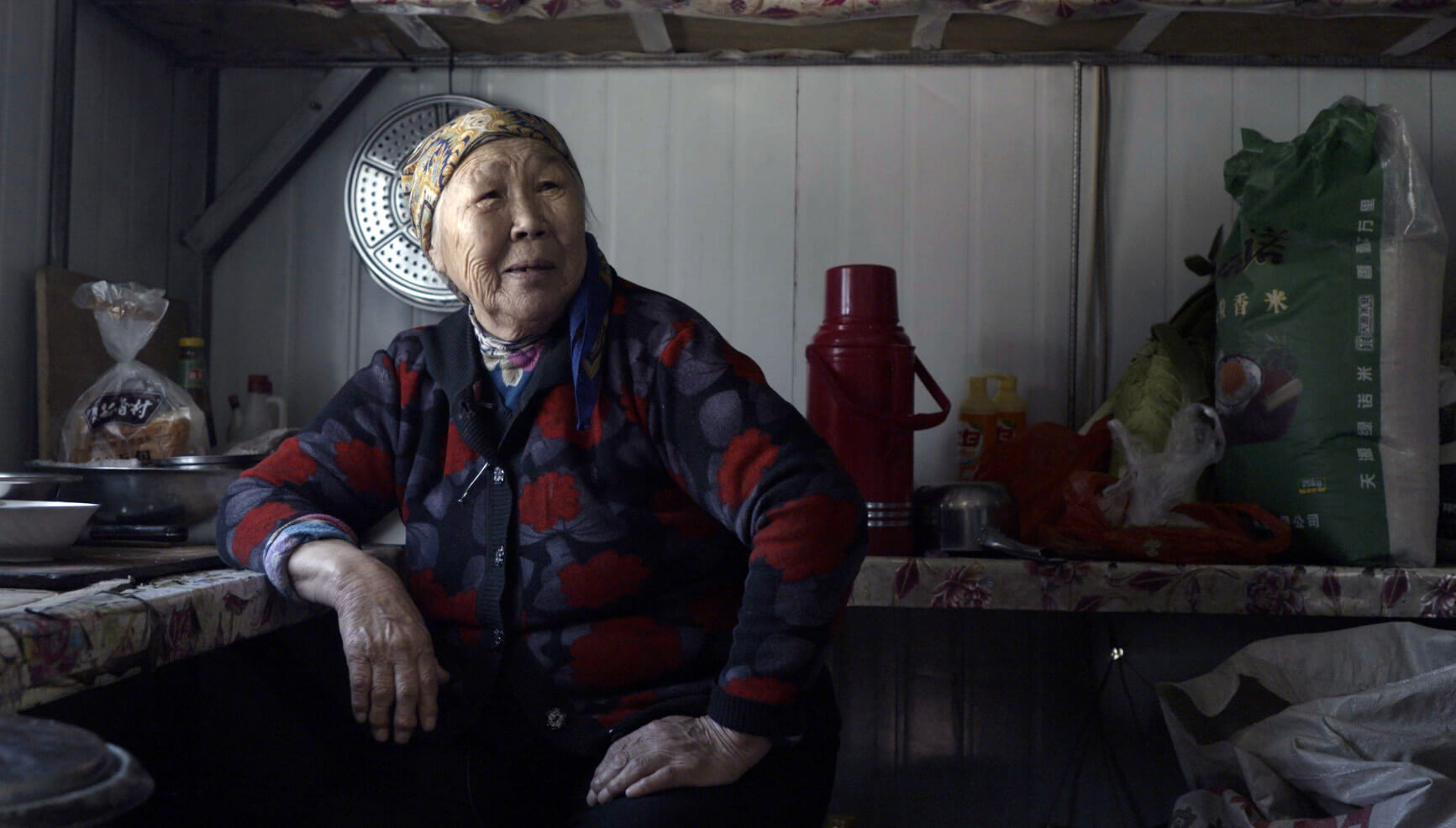
Zhong Nihao still remembers snatches of her childhood prior to the relocations.
Most shamanic rituals require the seer to attain an altered state of consciousness in order to commune with the spirits. Certain indigenous cultures — particularly those in South America — induce such a state through the use of psychoactive substances. Evenki shamans seem to have sung and danced their way into trance-like conditions, rhythmically striking a hand-held drum with a stick.
Time passed with no sign of the boy, but Kudrina was adamant that he was alive and well, having tracked down another Evenki group in the mountains by following the markings that hunters left on trees. “My aunt said [Kudrina] might have dreamt it,” Zhong recalls, “but the shaman said, ‘No, he is coming back. I can hear him walking on the road; he’s looking for his father.’”
Eventually, the boy was reunited with Zhong’s camp. “Despite the war, despite the hail of bullets, he didn’t die amid the gunfire,” she says. “He had just run off.”
Kudrina died in 1944. Local herders appointed her successors — Kudrina’s cousin and a woman named Njura Kaltakun — but both struggled to impose their authority on the remaining Evenki groups. Over time, the social role of later shamans was gradually marginalized as the newly empowered Communist government threw its weight behind the region’s industrialization and resettlement campaigns. The Chinese government does not classify shamanism as an official religion.
Some older herders say that on the day of Kaltakun’s death in 1998, a raging storm blackened the skies over the mountains and did not clear for an entire week. We ask Zhong if she still believes in all of it, in shamans and spirits and seances. Before she can answer, her daughter-in-law, Fan Suo — who is not Evenki by blood — interjects from across the cabin: “No, of course not! Isn’t that all just a bunch of legends?”
Eventually, Zhong replies. “I don’t know. I support the Communist Party. I don’t believe in anything,” she says, wearily. “But before liberation, I would go and seek out [Kudrina].”
New Homes, New Economy
In the mid-1950s, Zhong’s family came down from the mountains. In the Qiqian settlement, Zhong received Chinese-language education, and spent more and more time away from her former forest home.
When the government moved the Evenki and their reindeer to Old Aoluguya in 1965, local officials sought to bring animal husbandry in line with the nationwide collectivization of agriculture. The state bought ownership rights to the animals, but allowed their original herders to continue raising them. Officials also set up a so-called hunting production brigade, taking some of the Evenki’s meat and pelts in return for a salary. While their children attended school in Old Aoluguya, hunters still spent long periods in the mountains.
The government encouraged herders to breed livestock in greater numbers. By the 1970s, reindeer numbers had increased from several hundred to around 1,000, according to research by the scholar Lin. Most Evenki reportedly expressed satisfaction with this arrangement, often using their new permanent homes as a base from which to arrange hunting expeditions and participate in the antler industry.
Recognizing its value in Chinese medicine, the state later assumed the right to procure and sell the yearly antler crop. According to Kolås, the Oslo-based research professor, this was the first time the Evenki had sawed off their own animals’ antlers, having previously only obtained antler from wild deer shot on the hunt.

He Xie holds a photograph of himself and two friends at the former reindeer herding camp in Old Aoluguya.
According to research by Siqinfu, an ethnic Mongolian scholar of the Evenki who carried out studies in the region around the turn of the century, life in Old Aoluguya did much to assimilate the Evenki into Han culture. Children who attended the town’s boarding school were separated from their parents for long periods and taught in Mandarin. And by the 1970s, the local logging industry had brought in a sizable community of Han migrants.
In 1984, as China embraced the market economy, the government partially privatized reindeer husbandry, returning ownership of the animals to the 20 remaining herding families and signing contracts that granted them pasturing rights in certain areas. The production brigade was renamed a “hunting company,” though it increasingly targeted the still-lucrative antler industry, processing and packaging the antler in return for 20 percent of the profits.
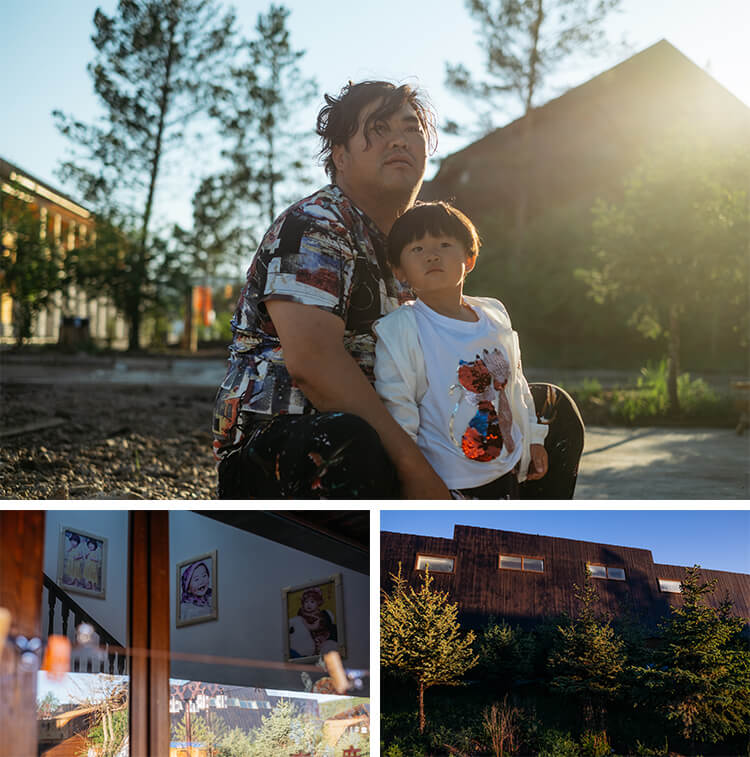
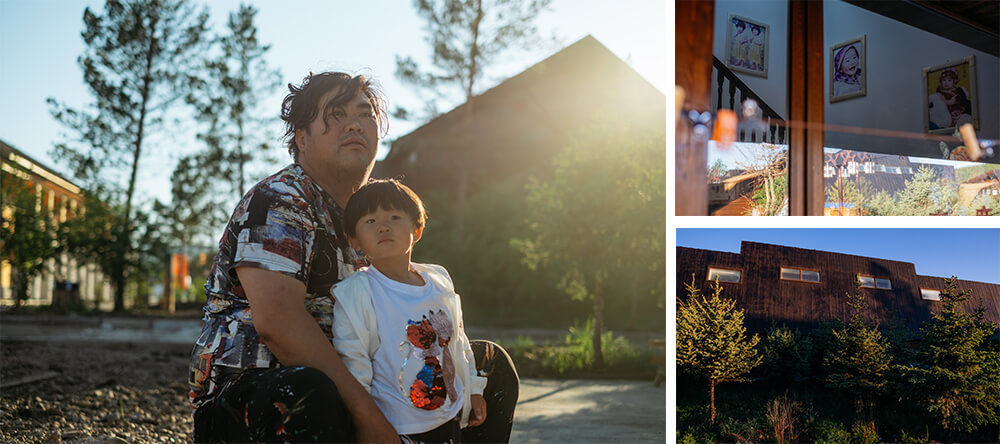
He Lei relaxes with his daughter in New Aoluguya (Above). Pictures line the walls of the family’s home (bottom left), which, like most new homes in the settlement, is sleek and modern (bottom right).
He Lei relaxes with his daughter in New Aoluguya (left). Pictures line the walls of the family’s home (top right), which, like most new homes in the settlement, is sleek and modern (bottom right).
Large numbers of reindeer required vast quantities of lichen. At the same time, an array of factors — including logging, illegal poaching, land clearance, and pesticide use — decimated the region’s flora and fauna. Evenki hunting grounds, much of which comprised virgin forests, shrank from an estimated 8 million hectares in 1950 to around 500,000 hectares by the 1990s, according to Siqinfu.
The environmental decline of the Greater Hinggan Mountains, once China’s biggest source of timber, deeply concerned the authorities. When officials decided to tackle the issue, herders found themselves in the crosshairs: The local government claimed that reindeer overgrazing was a cause of the area’s degradation.
Lin is skeptical of the government’s claims. “If you look at the number of reindeer and Evenki people from the late 1980s until now, they did not grow that much,” he says. (Siqinfu’s research shows that reindeer numbers actually fell from around 920 animals in 1992 to fewer than 600 by 1999.) “And there have been no new ways of using the taiga,” Lin adds, “so I really doubt if [reindeer-driven] damage was there and how large [it was].”
Local officials may also have thrown their weight behind the ecological migration project to secure much-needed funding from the national government, Lin suggests. “By using this term, they could [obtain] subsidies from the central level,” he explains. “This is very important for them because economically, Genhe is not a very developed area.”
In 1996, the national government rolled out a vast reforestation initiative that encouraged herders to bring livestock numbers under control. Later, the government confiscated herders’ hunting rifles, a move that had profound repercussions for Evenki identity, according to Zhong. “Losing our rifles was like losing your left arm, or your right leg,” she says.
When the Evenki were resettled most recently, in 2003, both the local government and state-sponsored media outlets cited the ecological migration policy as justification for the move. Multiple scholarly sources attest that the municipal government then signed an agreement with the state-owned Daqing Oilfield Company to manage the former site of Aoluguya. Researchers refer to domestic media reports of this event, but all of them now seem to have been expunged from the Chinese internet. (Daqing did not respond to our repeated phone calls and emails requesting information about its current interests in the area.)
Dai Guangming became New Aoluguya’s township head in 2011. A serious man with Evenki ancestry, he takes a pragmatic view of the ecological migration campaign. “All our infrastructure was failing,” he says of the former settlement. “Later, when we moved to our current location, people didn’t think about [leaving their homes] too much.”
Since the 1990s, both Chinese and Western scholars have focused their research on the loss of Evenki cultural heritage amid their ever-tighter embrace with a modern, consumerist economy. But for Dai, the benefits of the new settlement are clear. “The reality is that every aspect of life is more convenient down here,” he says. “Since [2003], our access to transportation, health care, and education has been transformed.”
Before moving to New Aoluguya, reindeer herders were more vulnerable to seasonal fluctuations in income, Dai says. In 2005, herders earned an average of 1,277 yuan per year, most of which was generated through hunting; by 2013, annual incomes had risen to 15,800 yuan, according to the Genhe municipal government. Although this figure is high compared to nearby rural areas, urban households in Genhe earn an average of nearly 25,000 yuan per year.
Dai steeples his fingers. “[The outside world] thinks our lives have changed, but the only thing that’s changed is the number of kilometers [between reindeer herders and the city],” he continues. “The mountains are only a temporary home. Previously, we only went into the mountains and hunted when we needed to. So what’s the difference between living there and living here? The way I see it, perhaps the only difference is that our standard of living is better here, and every family owns a car.”
Money and Malaise
Although New Aoluguya positions itself as a self-contained tourism zone, barriers to development remain. Regional infrastructure is hardly traveler-friendly; the nearest major airport is in Hailar, an industrial city more than 250 kilometers south. In addition, Genhe’s harsh climate restricts high season to just three months a year, from June to August.
Government figures state that Genhe welcomed 1.05 million visitors last year — 26 percent more than in 2016 — and generated nearly 1.5 billion yuan in revenue from tourism. However, the city’s jurisdiction is vast, encompassing mountains, wetlands, and logging towns strewn over an area of nearly 20,000 square kilometers. Individual figures for New Aoluguya are unavailable.
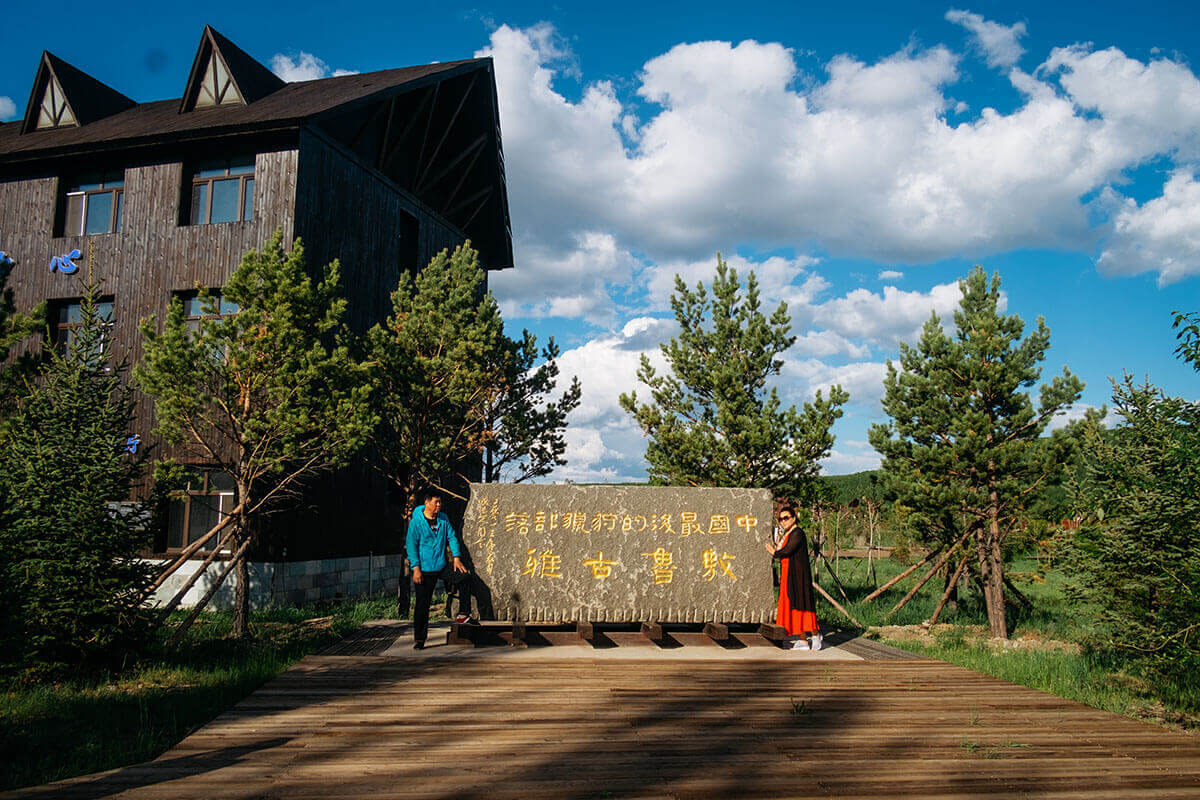
When we take a trip to the tourism zone in March, there are no visitors to be seen. The settlement’s residents stay indoors or smoke idly on their porches; some are completely absent. The site fares slightly better in June, when a few weekend picnickers stroll around the zone or buy tickets to the local museum of Evenki culture. But it’s hardly thronging with tourists.
Dai insists that a few visitors do come during the winter, and that he has faith in New Aoluguya’s future as a tourism hot spot. “We started our tourism industry from scratch, and it still hasn’t grown on a particularly large scale,” he says. “As more and more people understand our unique culture, the products of it — including our reputation and incomes — will rise every year.”
The government provides resettled herders and their families with a range of preferential policies. The state guarantees food and accommodation to the children of herding families from birth until the end of high school, and pays families a subsidy of 2,700 yuan for every year that a child stays in education between kindergarten and high school. It also pays for herders’ health insurance.
Dai is reticent about the impact of resettlement on Evenki culture. “I don’t think that just because we Evenki were forest people, the forest is still our home,” he says. “On the one hand, we have to protect our traditional culture. On the other, it’s crucial that we keep pace with the times. The country’s development has brought us profit and convenience; we can’t go on living like primitive people forever.”
The local language is particularly under threat. In 2010, UNESCO listed the Chinese dialects of Evenki as “severely endangered.” Most fluent speakers are elderly; the generation that came of age in the reform era, like Dai, know some Evenki but communicate in Mandarin; and while a local primary school for ethnic minority children holds regular Evenki classes, the rest of the curriculum is taught in Mandarin. “[These days], you have to speak fluent Chinese,” Dai says, “so nobody speaks Evenki anymore. Once they get to middle school and above, we can’t do anything about that.”
These days, young Evenki often migrate to other cities in China for work instead of staying in New Aoluguya. Lin, the Hangzhou-based scholar, says many such people no longer see the value of living in a community still somewhat removed from the rest of the population. “[They] have no sense of how their ancestors lived and do not understand why they need to be in Aoluguya, why they shouldn’t go to Genhe or other, larger cities,” Lin says. “This new way of life does not make sense for them.”
Amid New Aoluguya’s neat rows of houses, the final remnants of Evenki herding culture are disintegrating. But when we put this to local residents, most react with acceptance or helplessness. Since the 1950s, the general picture of Evenki life has been one of compromise: sustained enrichment in return for a sedentary lifestyle.
Today, the average herding family is materially wealthier than ever. But behind New Aoluguya’s opulence lies an inescapable sense of malaise. It sinks into your bones during dark, cold hours that pass with nothing to do. It dwells in the puffs of the day’s 20th cigarette, in the absent-minded munching on another bowl of rice, in the warm dregs at the bottom of last night’s beer bottles.
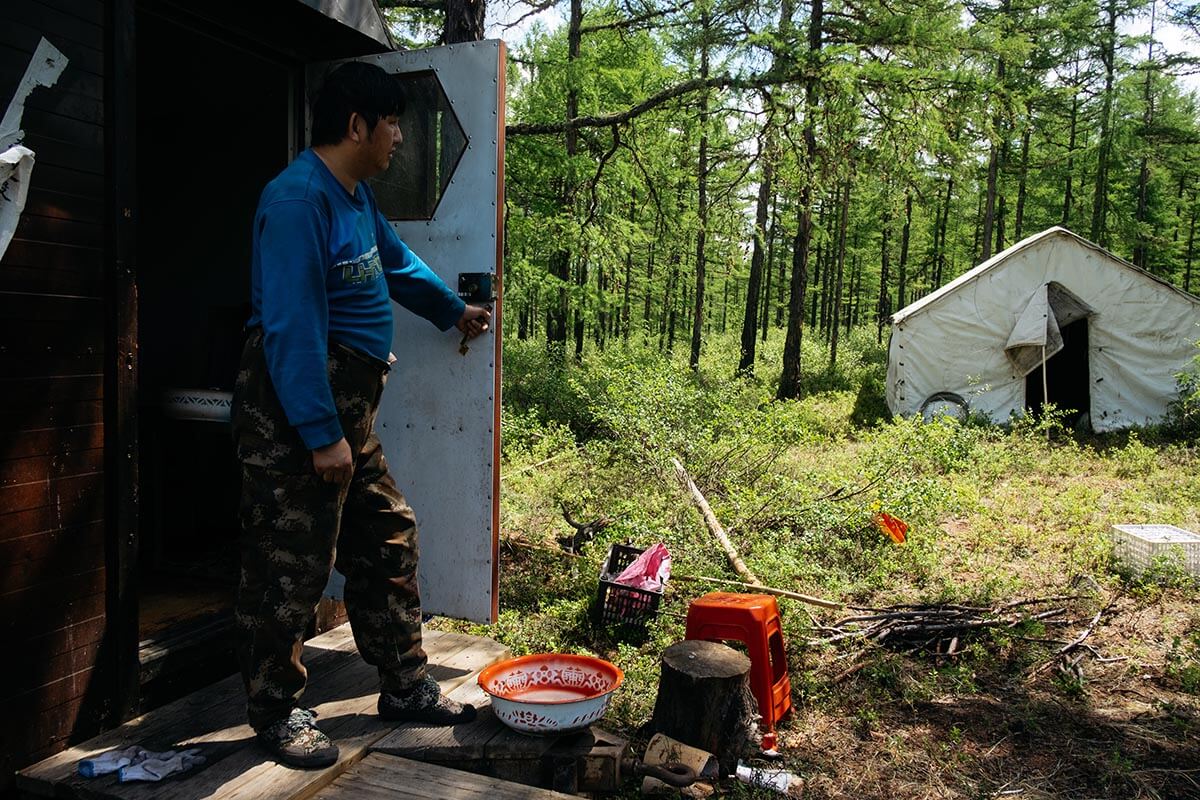
A man stands in the doorway of a forest camp near Genhe.
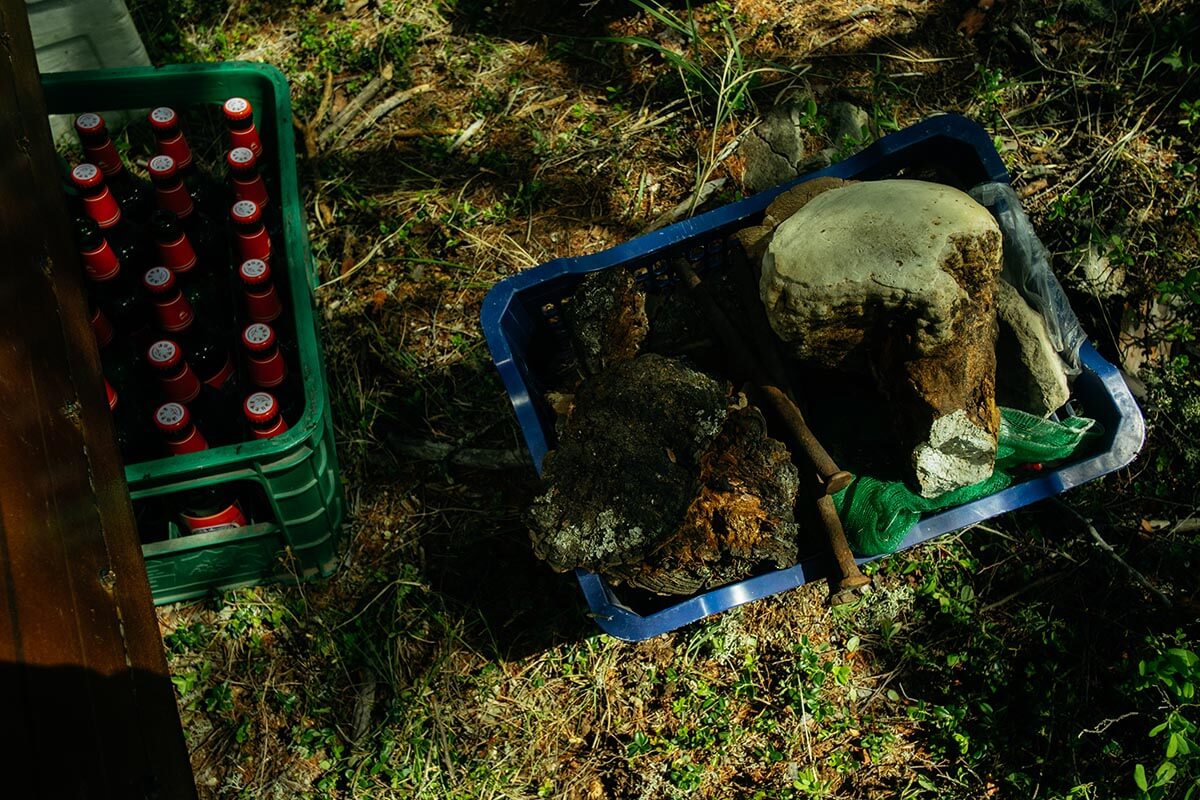
Bottles of beer stand in crates outside the camp.
Several of the Evenki we meet smoke compulsively, eat excessively, or — most prevalently — drink heavily. Almost everyone we interview betrays a predilection for immoderate alcohol consumption or alludes to the drinking problem of somebody they know.
According to Siqinfu, alcoholism became rife in the Evenki community in the mid-1960s. Citing statistics compiled by the government of Old Aoluguya, he says that as many as 83 Evenki died prematurely from heavy alcohol use, accidents — most of them alcohol-fueled — or suicide between 1957 and 1998. Many more were orphaned, abandoned by a parent, or born with physical or mental disabilities.
Today, the Chinese government keeps no statistics on rates of alcoholism among Evenki reindeer herders. Dai says the community has partially recovered, which he attributes to rising incomes and new forms of distraction. “When we hunted for a living, we spent a lot of time idle. It wasn’t like today — now you can take out your mobile phone and get in touch with anyone,” he says. “Back then, drinking was the most fun you could have, so it was unavoidable that people would drink too much.”
Despite the behavior we witnessed among certain herders, it is true that nowadays, many Evenki don’t drink or do so in moderation. Perhaps understandably, men in the community prickle when the subject of alcoholism is raised. He Lei says reindeer herding is a slow and solitary vocation, one that lends itself to drinking: “If you got dumped in the mountains for eight, 10 days at a time, you’d drink as well. It’s boring. There’s nothing up there. No lights, nothing. At night, you just lie around with nothing to do.”
He grows visibly heated when we ask if he frequently sees conflicts break out among Evenki people who drink heavily. “Everyone loses their temper with other people sometimes. Aren’t you the same?” he says. “Everyone drinks. You’re in the mountains, you’re bored, so you drink. Some things aren’t the way you think they are.”
Like Dai, He Lei agrees that smartphones, computers, and other forms of technology are reducing alcohol consumption among younger generations of Evenki. He personally gave up smoking and drinking in April, after he was diagnosed with heart disease. He turns 34 this year.
Fifteen years ago, few in the community were so health-conscious. “People who drank too much back then aren’t around now,” Dai says. “They all drank themselves to death.”
Holding On
Some herders openly reject resettlement in New Aoluguya. Liu Xia, for example, lives in a far-flung forest encampment near Alongshan, a former logging town about 150 kilometers north of Genhe. In resisting the lure of material wealth to spend her days in the wilderness, Liu arguably preserves certain characteristics of Evenki culture better than people in the tourism zone — particularly her love for her reindeer.
Although Liu is part owner of a house in the new settlement, the 56-year-old doesn’t want to live there. “Whenever I leave the mountains, I miss this place,” she says, adding that she is unwilling to follow other Evenki into the tourism industry. “I find it embarrassing to ask for money,” she says. “As long as I have enough to eat, I’m fine.”
Her herd — around a dozen deer — also draws her inexorably back to the forest. “I just can’t leave them,” she says. “When I leave the mountains, I miss them.”
Research by the Cambridge-based scholar Richard Fraser suggests that the Evenki, like many indigenous peoples of northern Asia, attribute personhood not just to other humans, but also to nonhuman agents like reindeer and the natural features of the forest. Because meaningful interactions with these agents are key to the Evenki experience, Fraser writes, relocation outside their taiga homeland may produce profound feelings of pain, loss, and existential angst. Citing case studies of other relocated peoples, Fraser also notes that the negative feelings that can accompany resettlement sometimes seem to provoke or exacerbate physical and psychological health problems.
Some herders, like Liu Xia, choose to live in the wilderness instead of New Aoluguya.
Life out here is far harder than in New Aoluguya, but Liu enjoys the tranquility of the taiga. She sleeps in a large plastic tent that houses a pair of raised bunks, an old chair, and a blackened brick hearth for cooking. Outside, two solar panels provide electricity for a couple of light bulbs and, somewhat improbably, a small flat-screen TV.
But rejecting modern life brings complications. Because Liu no longer hunts with guns, she relies on friends in Alongshan to periodically bring her food and other provisions — about an hour’s drive each way. Her camp has no internet connection or mobile phone signal, preventing her from staying in touch with her adult son who lives away from New Aoluguya.
Liu’s most recent return to the settlement was last year, when chronic shoulder pain forced her to consult a doctor at a hospital in Genhe. In Alongshan — one of a constellation of decaying northern timber towns — the necessary medical care was unavailable. And Liu lives with other ailments, too: She walks with a limp and struggles with excessive alcohol use. Although the latter issue is improving, it still dissuades her from returning to the new settlement. “Whenever you go to someone else’s house, you have to drink,” she explains.
Liu was born in Qiqian, the border town where the original Evenki settlement stood. She attended five years of formal education but disliked school, which kept Evenki children from seeing their forest-roaming families. “I wasn’t happy staying there and would run back into the mountains,” she remembers. “Once I left, I wouldn’t come back down for several months.”
Throughout her youth, Liu found solace in forest life. She remembers with fondness her grandmother, who she claims was the shaman whose death precipitated a weeklong storm. One day while her family was out, a young, bored Liu decided to emulate the older woman: “I thought about how fun it was when Grandma performed the spirit dance, so I took out her costume and put it on. It was so heavy, with birds and other animals all over it. Then I put on her hat and looked in the mirror — I looked so scary! And I beat the sun drum. My neighbors heard me and came running in, shouting, ‘What are you doing?’ They frightened me so much I didn’t dare dance again.”


Liu Xia stands in the doorway of her plastic tent in the forest near Alongshan (Above). Inside, pillows and quilts lie on the raised bed (Bottom left), and cooking utensils line one of the walls (bottom right).
Liu Xia stands in the doorway of her plastic tent in the forest near Alongshan (left). Inside, pillows and quilts lie on the raised bed (top right), and cooking utensils line one of the walls (bottom right).
Liu’s family moved to Old Aoluguya in the mid-1960s, but Liu refused to move again in 2003. Perhaps due to her isolation, she retains certain habits that younger generations of Evenki tend to lack. For instance, she speaks of shamanic power with an earnestness that stands in stark contrast to the doubtful tone taken by her younger peers.
“Grandma liked to sing until the sun came up,” Liu says, adding that one of her cousins took exception to the elderly woman’s crooning one night and went to stay with another family. “When my aunt got up the next morning … Grandma scolded her, asking her in Evenki why she had raised her damn son so badly. Afterward … [my aunt’s] three sons all died within nine years. The eldest drank himself to death, as did the second son. The third went to prison and died soon after he got out. Three sons in nine years! My Grandma had told her, ‘You’ll end up with nobody left, only one grandson.’ And that grandson never dared insult a shaman — if Grandma wanted to sing, he let her.”
Perhaps most strikingly, Liu attributes humanlike personalities and motivations to animals. When she describes the bears that occasionally come and menace her reindeer, she characterizes them as vengeful creatures that resent herders who step in to protect their animals from harm. “You mustn’t insult an animal like that,” she says. “If you insult them, you’re done for.”
For Liu, the spiritual fulfillment of being in the forest with her reindeer is more valuable than the comparative affluence of life in New Aoluguya. This spring, one of her doe gave birth to a fawn. Liu named the newborn Little Sun, “because after it came out, the child kept staring upward like this,” she says, tilting back her head and narrowing her eyes. During our June interview, she wanders out of the tent several times to check on Little Sun, feeding him treats by hand.
Liu’s serenity around her reindeer is a sharp contrast to her mood the first time we met her, in March. Back then, the snow stood a foot high, her tent was full of visitors, and her reindeer were foraging far from the camp. Confused and flustered, Liu withdrew into herself and dodged our questions. But she did mention something that, months later, we finally understood.
“Without reindeer,” she said, “we’re not Evenki anymore.”
